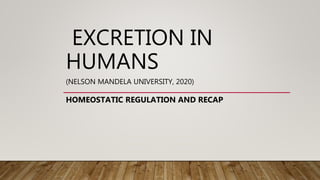HUMAN EXCRETION PRESENTATION.pptx
- 1. EXCRETION IN HUMANS (NELSON MANDELA UNIVERSITY, 2020) HOMEOSTATIC REGULATION AND RECAP
- 2. RECAP ŌĆó The kidney is involved in 3 homeostatic mechanisms namely: ’üČ The regulation of water levels (Osmoregulation) ’üČThe regulation of salt levels in the blood ’üČThe regulation of PH of the blood
- 3. INTRO QUESTIONS 1. What is osmoregulation? 2. What is Homeostasis? 3. What is an ADH or what does it stand for?
- 5. THE REGULATION OF WATER LEVELS Too little water in the blood Too much water in the blood Dehydration is when the blood and tissue fluid are short of water. Overhydration occurs when the blood and tissue fluids are very dilute. This can be brought about by excessive exercise, hot temperatures, increased sweating or decreased water intake. This can be because of cooler temperatures, little exercise with no sweating and an excessive intake of water. This low level of H2O is detected by the hypothalamus of the brain. Water levels are elevated, and this is detected by the hypothalamus. The pituitary gland releases antidiuretic hormone (ADH) The pituitary gland releases less ADH. The hormone is transported in the blood to the kidney. The permeability of the collecting duct and the distal convoluted tubule is increased Collecting ducts and distal convoluted tubules in the kidney become less permeable More H2O is absorbed and passed into the blood. Less H2O is absorbed into the blood. The blood becomes more dilute and less, concentrated urine is excreted. Less water leaves the collecting duct and more, dilute urine is excreted.
- 6. THE REGULATIONS OF SALT (SODIUM) LEVELS IN THE BLOOD (SCIENCE_LABLINKS, 2008) Low salt levels in blood and tissue fluids make fluids hypotonic Elevated salt levels in the blood / tissue fluids these fluids hypertonic. Receptor cells in the afferent and efferent arterioles of the glomeruli of the kidney will detect decreased Na+ levels. Receptor cells in the afferent and efferent arterioles will detect an increased presence of Na+ . The adrenal gland in the kidney secretes the hormone aldosterone. The adrenal gland will stop releasing aldosterone. Aldosterone stimulates the reabsorption of Na+ from the filtrate and back into the blood. Na+ will not be reabsorbed. Less sodium is excreted in the urine. More sodium is excreted in the urine.
- 7. (NELSON MANDELA UNIVERSITY, 2020)
- 8. KIDNEY DISEASES ADAPTED FROM: HTTPS://DINWIDDIEHIGHSCHOOL.CO.ZA/WP-CONTENT/UPLOADS/2020/11/GRD-11- TEXTBOOK.PDF
- 10. FUNCTIONING OF A DIALYSIS MACHINE ADAPTED FROM: HTTPS://DINWIDDIEHIGHSCHOOL.CO.ZA/WP-CONTENT/UPLOADS/2020/11/GRD-11- TEXTBOOK.PDF
- 11. PERITONEAL DIALYSIS ADAPTED FROM: HTTPS://DINWIDDIEHIGHSCHOOL.CO.ZA/WP-CONTENT/UPLOADS/2020/11/GRD-11- TEXTBOOK.PDF
- 12. ŌĆó Dialysis has the following disadvantages: ŌĆó Dialysis is time consuming and expensive. ŌĆó The patient is often tired after dialysis and cannot work. ŌĆó Dialysis cannot remove all the waste in the blood. ŌĆó The only long-term solution to kidney failure, is a kidney transplant. (Nelson Mandela University, 2020) & (Sai Ram, 2015) ALTHOUGH DIALYSIS IS A SOLUTION OF KIDNEY FAILURE
- 13. KIDNEY TRANSPLANT ŌĆó A patient with both kidneys seriously damaged could be considered for a kidney transplant. A donor donates one of their kidneys to the patient with kidney failure (the recipient). (Kar Neng Lai & Tang, 2011) ŌĆó A person would be a suitable donor if he or she has the same blood group (A, B, AB or O) as the intended recipient, and if they have a very close tissue match. The ideal donor would be a blood relative of the patient. ŌĆó The recipient might reject the donated kidney and is given immunosuppressive drugs to reduce the chances of organ rejection. These drugs can have bad side-effects and there is often a shortage of organ donors. ŌĆó There are legal and ethical aspects of organ donation that need to be considered by donors and recipients in South Africa.
- 14. REFERENCE LIST ŌĆó Kar Neng Lai, & Tang, S. C. W. (2011). Diabetes and the kidney. Karger. ŌĆó science_lablinks. (2008, July 21). HOMEOSTASIS. ║▌║▌▀Żshare.com. /science_lablinks/homeostasis-523470 ŌĆó Sai Ram. (2015, March 22). Dialysis. ║▌║▌▀Ż Share. /dsairamsairam/dialysis-46145731 ŌĆó Video 1: https://youtu.be/gRoleVEwR8c ŌĆó Video 2: https://youtu.be/IQKQ4eoKfTg ŌĆó Nelson Mandela University. (2020). LIFE SCIENCES Grade 11 Textbook. https://dinwiddiehighschool.co.za/wp-content/uploads/2020/11/grd-11-textbook.pdf














